University Research Report: Research Methodology and Literature Review
VerifiedAdded on 2022/08/13
|15
|3836
|23
Report
AI Summary
This research report examines research methodology, including inductive and deductive approaches, research design (exploratory, explanatory, and descriptive), and sampling techniques (probability and non-probability). It explores the importance of literature review, its objectives, and its role in a study. The report discusses the purpose of a literature review, how it demonstrates the understanding of the subject matter, and how it helps in identifying research gaps and justifying the research. It also covers the significance of related literature in a study and its contribution to the development of knowledge. The report emphasizes the importance of evaluating sources and integrating discussions into arguments. The assignment aims to understand research methods in education and academic writing, including plagiarism avoidance.
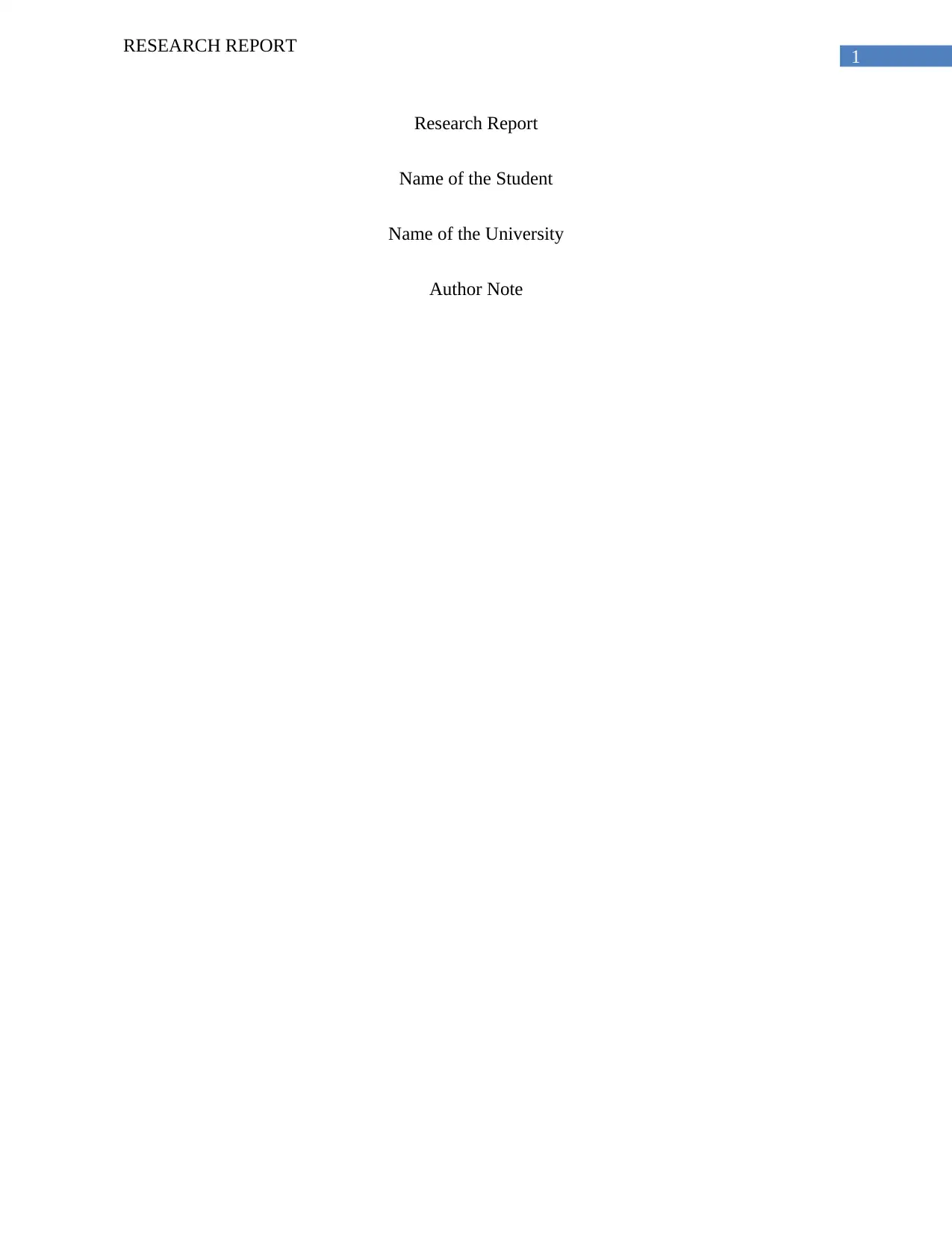
1
RESEARCH REPORT
Research Report
Name of the Student
Name of the University
Author Note
RESEARCH REPORT
Research Report
Name of the Student
Name of the University
Author Note
Paraphrase This Document
Need a fresh take? Get an instant paraphrase of this document with our AI Paraphraser
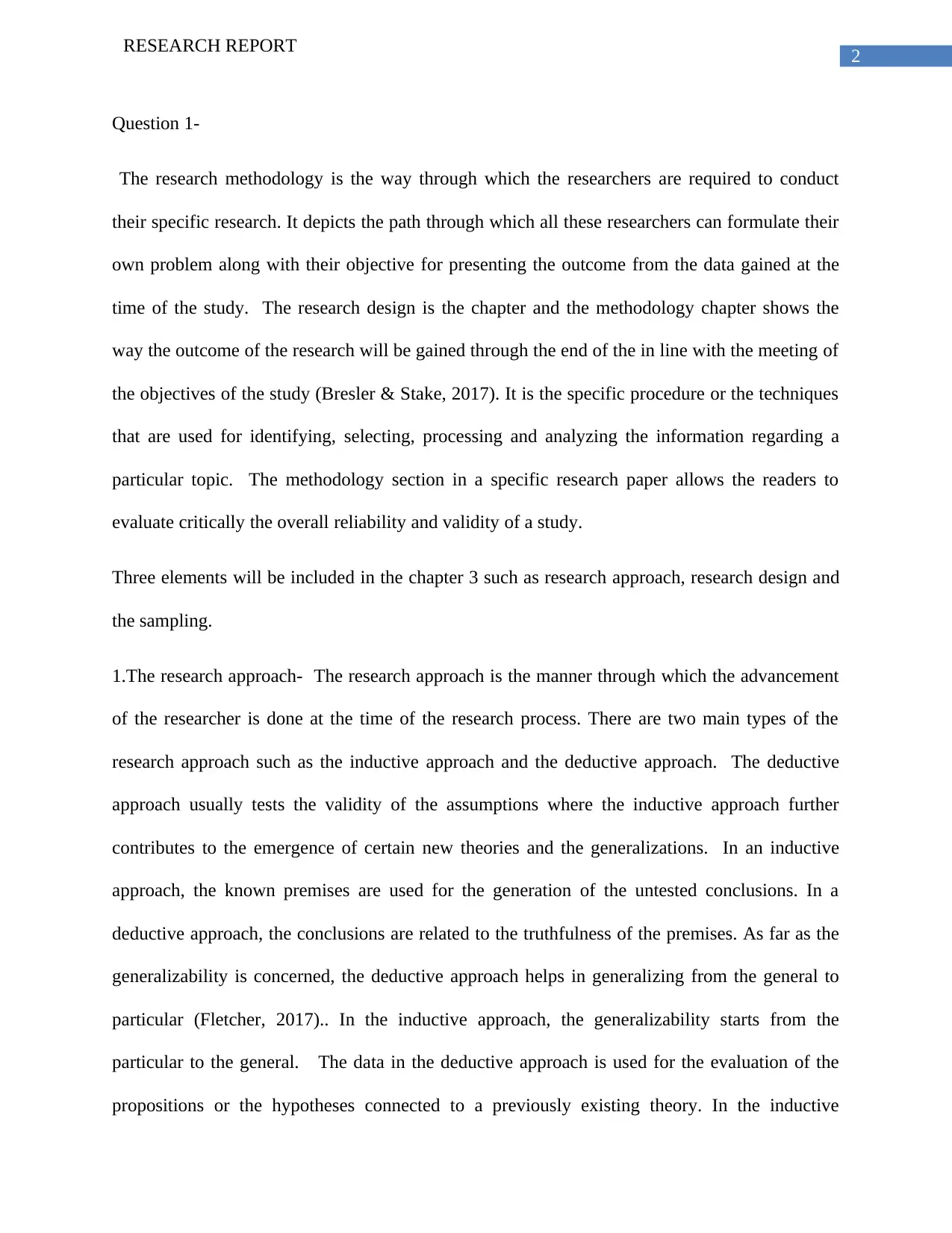
2
RESEARCH REPORT
Question 1-
The research methodology is the way through which the researchers are required to conduct
their specific research. It depicts the path through which all these researchers can formulate their
own problem along with their objective for presenting the outcome from the data gained at the
time of the study. The research design is the chapter and the methodology chapter shows the
way the outcome of the research will be gained through the end of the in line with the meeting of
the objectives of the study (Bresler & Stake, 2017). It is the specific procedure or the techniques
that are used for identifying, selecting, processing and analyzing the information regarding a
particular topic. The methodology section in a specific research paper allows the readers to
evaluate critically the overall reliability and validity of a study.
Three elements will be included in the chapter 3 such as research approach, research design and
the sampling.
1.The research approach- The research approach is the manner through which the advancement
of the researcher is done at the time of the research process. There are two main types of the
research approach such as the inductive approach and the deductive approach. The deductive
approach usually tests the validity of the assumptions where the inductive approach further
contributes to the emergence of certain new theories and the generalizations. In an inductive
approach, the known premises are used for the generation of the untested conclusions. In a
deductive approach, the conclusions are related to the truthfulness of the premises. As far as the
generalizability is concerned, the deductive approach helps in generalizing from the general to
particular (Fletcher, 2017).. In the inductive approach, the generalizability starts from the
particular to the general. The data in the deductive approach is used for the evaluation of the
propositions or the hypotheses connected to a previously existing theory. In the inductive
RESEARCH REPORT
Question 1-
The research methodology is the way through which the researchers are required to conduct
their specific research. It depicts the path through which all these researchers can formulate their
own problem along with their objective for presenting the outcome from the data gained at the
time of the study. The research design is the chapter and the methodology chapter shows the
way the outcome of the research will be gained through the end of the in line with the meeting of
the objectives of the study (Bresler & Stake, 2017). It is the specific procedure or the techniques
that are used for identifying, selecting, processing and analyzing the information regarding a
particular topic. The methodology section in a specific research paper allows the readers to
evaluate critically the overall reliability and validity of a study.
Three elements will be included in the chapter 3 such as research approach, research design and
the sampling.
1.The research approach- The research approach is the manner through which the advancement
of the researcher is done at the time of the research process. There are two main types of the
research approach such as the inductive approach and the deductive approach. The deductive
approach usually tests the validity of the assumptions where the inductive approach further
contributes to the emergence of certain new theories and the generalizations. In an inductive
approach, the known premises are used for the generation of the untested conclusions. In a
deductive approach, the conclusions are related to the truthfulness of the premises. As far as the
generalizability is concerned, the deductive approach helps in generalizing from the general to
particular (Fletcher, 2017).. In the inductive approach, the generalizability starts from the
particular to the general. The data in the deductive approach is used for the evaluation of the
propositions or the hypotheses connected to a previously existing theory. In the inductive
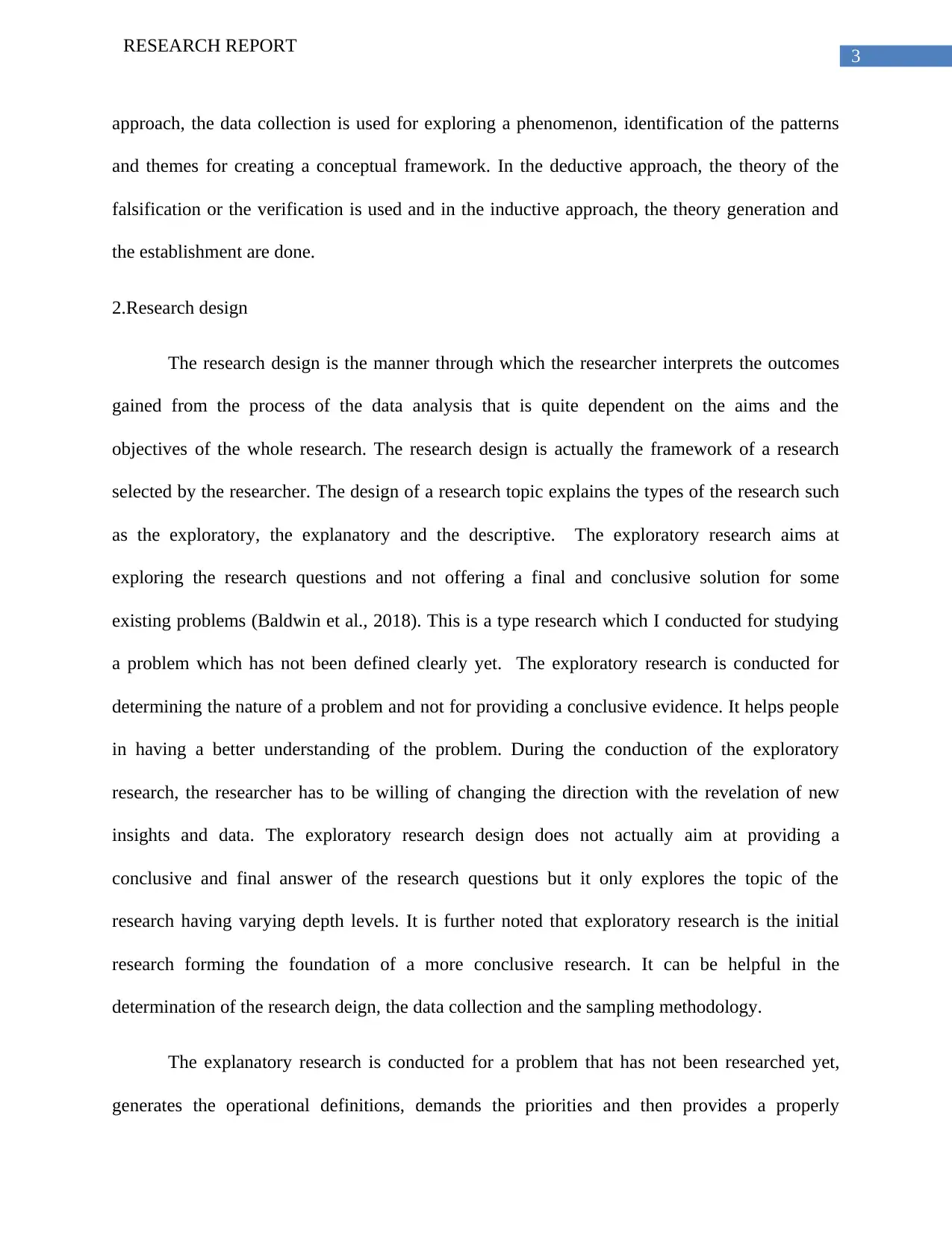
3
RESEARCH REPORT
approach, the data collection is used for exploring a phenomenon, identification of the patterns
and themes for creating a conceptual framework. In the deductive approach, the theory of the
falsification or the verification is used and in the inductive approach, the theory generation and
the establishment are done.
2.Research design
The research design is the manner through which the researcher interprets the outcomes
gained from the process of the data analysis that is quite dependent on the aims and the
objectives of the whole research. The research design is actually the framework of a research
selected by the researcher. The design of a research topic explains the types of the research such
as the exploratory, the explanatory and the descriptive. The exploratory research aims at
exploring the research questions and not offering a final and conclusive solution for some
existing problems (Baldwin et al., 2018). This is a type research which I conducted for studying
a problem which has not been defined clearly yet. The exploratory research is conducted for
determining the nature of a problem and not for providing a conclusive evidence. It helps people
in having a better understanding of the problem. During the conduction of the exploratory
research, the researcher has to be willing of changing the direction with the revelation of new
insights and data. The exploratory research design does not actually aim at providing a
conclusive and final answer of the research questions but it only explores the topic of the
research having varying depth levels. It is further noted that exploratory research is the initial
research forming the foundation of a more conclusive research. It can be helpful in the
determination of the research deign, the data collection and the sampling methodology.
The explanatory research is conducted for a problem that has not been researched yet,
generates the operational definitions, demands the priorities and then provides a properly
RESEARCH REPORT
approach, the data collection is used for exploring a phenomenon, identification of the patterns
and themes for creating a conceptual framework. In the deductive approach, the theory of the
falsification or the verification is used and in the inductive approach, the theory generation and
the establishment are done.
2.Research design
The research design is the manner through which the researcher interprets the outcomes
gained from the process of the data analysis that is quite dependent on the aims and the
objectives of the whole research. The research design is actually the framework of a research
selected by the researcher. The design of a research topic explains the types of the research such
as the exploratory, the explanatory and the descriptive. The exploratory research aims at
exploring the research questions and not offering a final and conclusive solution for some
existing problems (Baldwin et al., 2018). This is a type research which I conducted for studying
a problem which has not been defined clearly yet. The exploratory research is conducted for
determining the nature of a problem and not for providing a conclusive evidence. It helps people
in having a better understanding of the problem. During the conduction of the exploratory
research, the researcher has to be willing of changing the direction with the revelation of new
insights and data. The exploratory research design does not actually aim at providing a
conclusive and final answer of the research questions but it only explores the topic of the
research having varying depth levels. It is further noted that exploratory research is the initial
research forming the foundation of a more conclusive research. It can be helpful in the
determination of the research deign, the data collection and the sampling methodology.
The explanatory research is conducted for a problem that has not been researched yet,
generates the operational definitions, demands the priorities and then provides a properly
⊘ This is a preview!⊘
Do you want full access?
Subscribe today to unlock all pages.

Trusted by 1+ million students worldwide
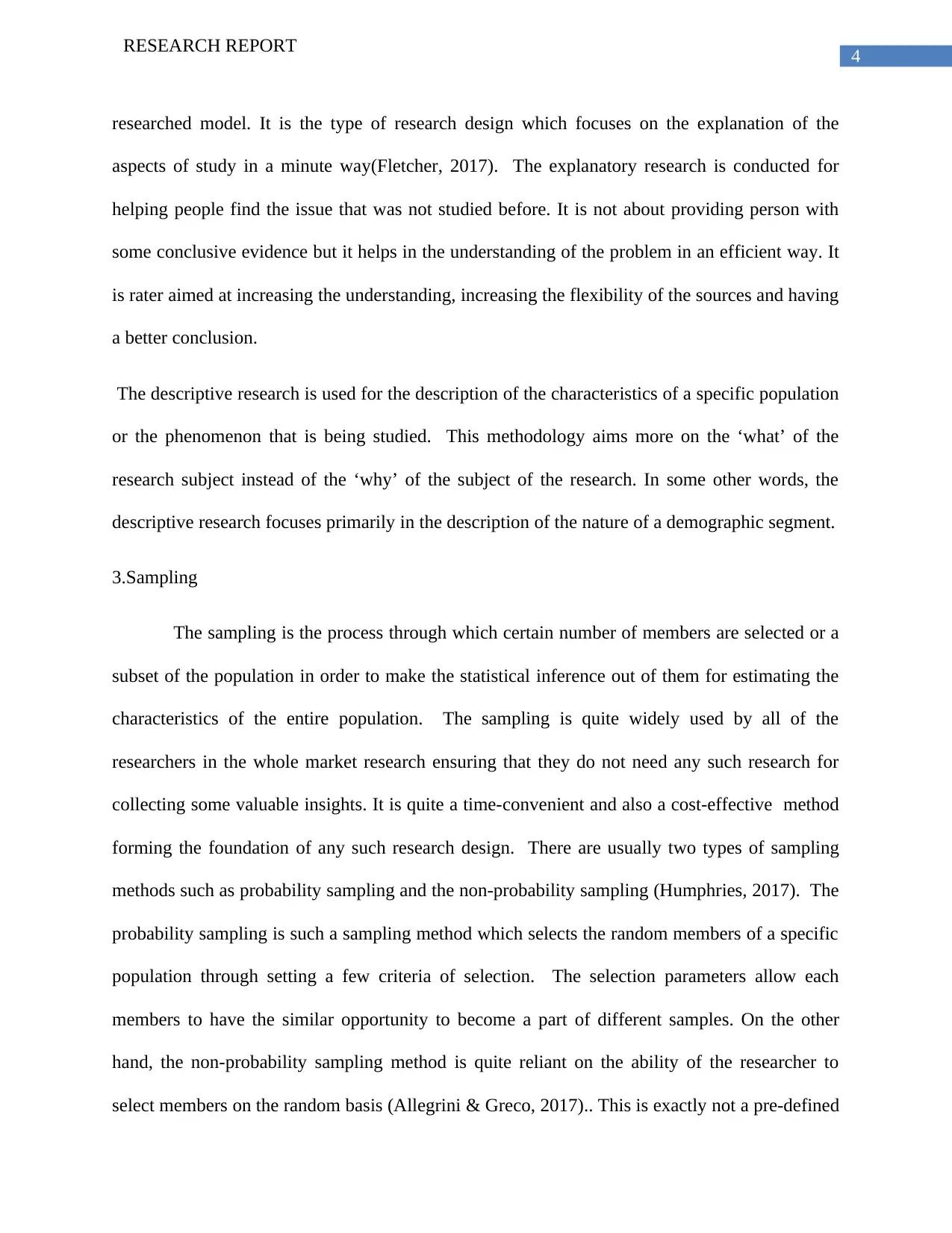
4
RESEARCH REPORT
researched model. It is the type of research design which focuses on the explanation of the
aspects of study in a minute way(Fletcher, 2017). The explanatory research is conducted for
helping people find the issue that was not studied before. It is not about providing person with
some conclusive evidence but it helps in the understanding of the problem in an efficient way. It
is rater aimed at increasing the understanding, increasing the flexibility of the sources and having
a better conclusion.
The descriptive research is used for the description of the characteristics of a specific population
or the phenomenon that is being studied. This methodology aims more on the ‘what’ of the
research subject instead of the ‘why’ of the subject of the research. In some other words, the
descriptive research focuses primarily in the description of the nature of a demographic segment.
3.Sampling
The sampling is the process through which certain number of members are selected or a
subset of the population in order to make the statistical inference out of them for estimating the
characteristics of the entire population. The sampling is quite widely used by all of the
researchers in the whole market research ensuring that they do not need any such research for
collecting some valuable insights. It is quite a time-convenient and also a cost-effective method
forming the foundation of any such research design. There are usually two types of sampling
methods such as probability sampling and the non-probability sampling (Humphries, 2017). The
probability sampling is such a sampling method which selects the random members of a specific
population through setting a few criteria of selection. The selection parameters allow each
members to have the similar opportunity to become a part of different samples. On the other
hand, the non-probability sampling method is quite reliant on the ability of the researcher to
select members on the random basis (Allegrini & Greco, 2017).. This is exactly not a pre-defined
RESEARCH REPORT
researched model. It is the type of research design which focuses on the explanation of the
aspects of study in a minute way(Fletcher, 2017). The explanatory research is conducted for
helping people find the issue that was not studied before. It is not about providing person with
some conclusive evidence but it helps in the understanding of the problem in an efficient way. It
is rater aimed at increasing the understanding, increasing the flexibility of the sources and having
a better conclusion.
The descriptive research is used for the description of the characteristics of a specific population
or the phenomenon that is being studied. This methodology aims more on the ‘what’ of the
research subject instead of the ‘why’ of the subject of the research. In some other words, the
descriptive research focuses primarily in the description of the nature of a demographic segment.
3.Sampling
The sampling is the process through which certain number of members are selected or a
subset of the population in order to make the statistical inference out of them for estimating the
characteristics of the entire population. The sampling is quite widely used by all of the
researchers in the whole market research ensuring that they do not need any such research for
collecting some valuable insights. It is quite a time-convenient and also a cost-effective method
forming the foundation of any such research design. There are usually two types of sampling
methods such as probability sampling and the non-probability sampling (Humphries, 2017). The
probability sampling is such a sampling method which selects the random members of a specific
population through setting a few criteria of selection. The selection parameters allow each
members to have the similar opportunity to become a part of different samples. On the other
hand, the non-probability sampling method is quite reliant on the ability of the researcher to
select members on the random basis (Allegrini & Greco, 2017).. This is exactly not a pre-defined
Paraphrase This Document
Need a fresh take? Get an instant paraphrase of this document with our AI Paraphraser
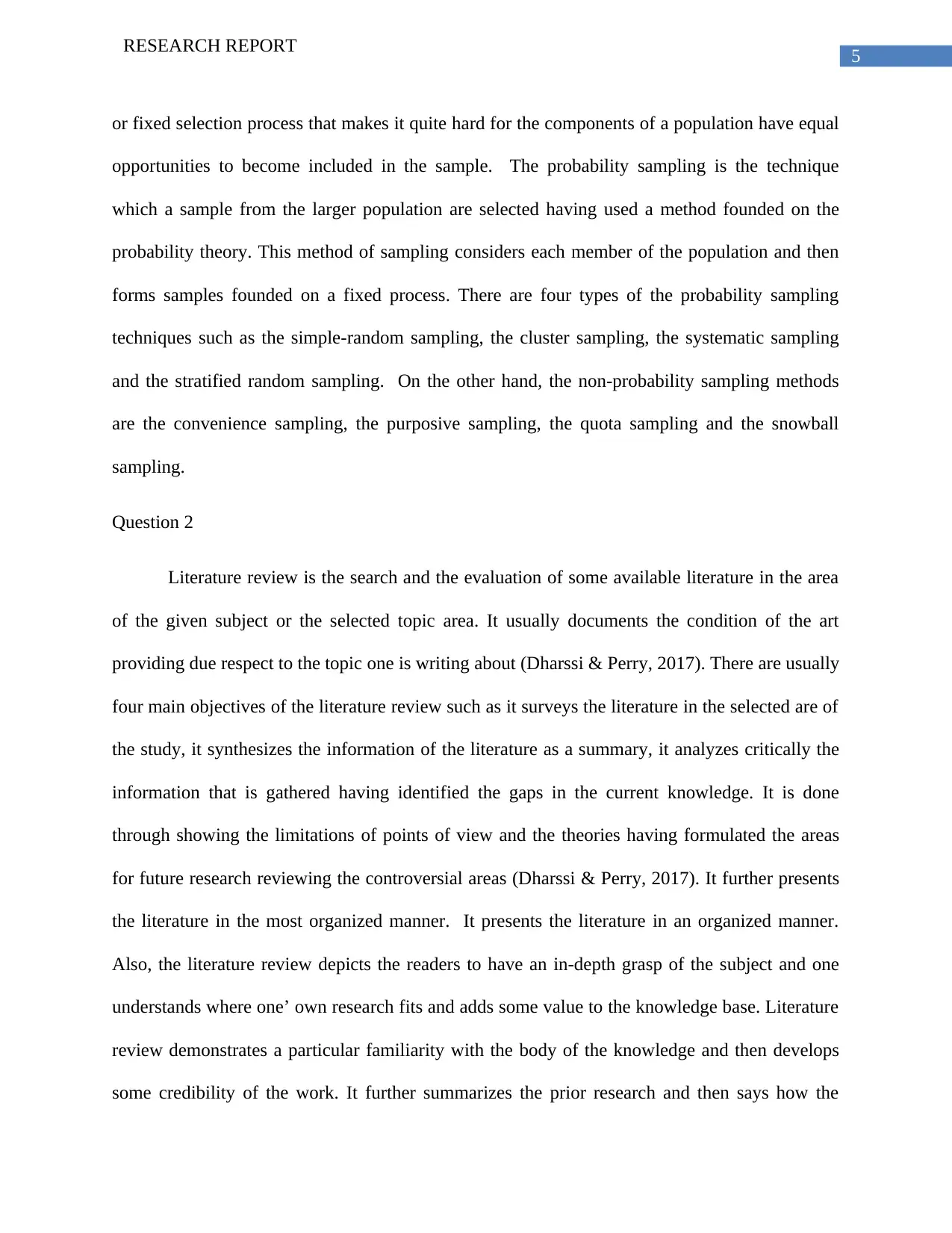
5
RESEARCH REPORT
or fixed selection process that makes it quite hard for the components of a population have equal
opportunities to become included in the sample. The probability sampling is the technique
which a sample from the larger population are selected having used a method founded on the
probability theory. This method of sampling considers each member of the population and then
forms samples founded on a fixed process. There are four types of the probability sampling
techniques such as the simple-random sampling, the cluster sampling, the systematic sampling
and the stratified random sampling. On the other hand, the non-probability sampling methods
are the convenience sampling, the purposive sampling, the quota sampling and the snowball
sampling.
Question 2
Literature review is the search and the evaluation of some available literature in the area
of the given subject or the selected topic area. It usually documents the condition of the art
providing due respect to the topic one is writing about (Dharssi & Perry, 2017). There are usually
four main objectives of the literature review such as it surveys the literature in the selected are of
the study, it synthesizes the information of the literature as a summary, it analyzes critically the
information that is gathered having identified the gaps in the current knowledge. It is done
through showing the limitations of points of view and the theories having formulated the areas
for future research reviewing the controversial areas (Dharssi & Perry, 2017). It further presents
the literature in the most organized manner. It presents the literature in an organized manner.
Also, the literature review depicts the readers to have an in-depth grasp of the subject and one
understands where one’ own research fits and adds some value to the knowledge base. Literature
review demonstrates a particular familiarity with the body of the knowledge and then develops
some credibility of the work. It further summarizes the prior research and then says how the
RESEARCH REPORT
or fixed selection process that makes it quite hard for the components of a population have equal
opportunities to become included in the sample. The probability sampling is the technique
which a sample from the larger population are selected having used a method founded on the
probability theory. This method of sampling considers each member of the population and then
forms samples founded on a fixed process. There are four types of the probability sampling
techniques such as the simple-random sampling, the cluster sampling, the systematic sampling
and the stratified random sampling. On the other hand, the non-probability sampling methods
are the convenience sampling, the purposive sampling, the quota sampling and the snowball
sampling.
Question 2
Literature review is the search and the evaluation of some available literature in the area
of the given subject or the selected topic area. It usually documents the condition of the art
providing due respect to the topic one is writing about (Dharssi & Perry, 2017). There are usually
four main objectives of the literature review such as it surveys the literature in the selected are of
the study, it synthesizes the information of the literature as a summary, it analyzes critically the
information that is gathered having identified the gaps in the current knowledge. It is done
through showing the limitations of points of view and the theories having formulated the areas
for future research reviewing the controversial areas (Dharssi & Perry, 2017). It further presents
the literature in the most organized manner. It presents the literature in an organized manner.
Also, the literature review depicts the readers to have an in-depth grasp of the subject and one
understands where one’ own research fits and adds some value to the knowledge base. Literature
review demonstrates a particular familiarity with the body of the knowledge and then develops
some credibility of the work. It further summarizes the prior research and then says how the
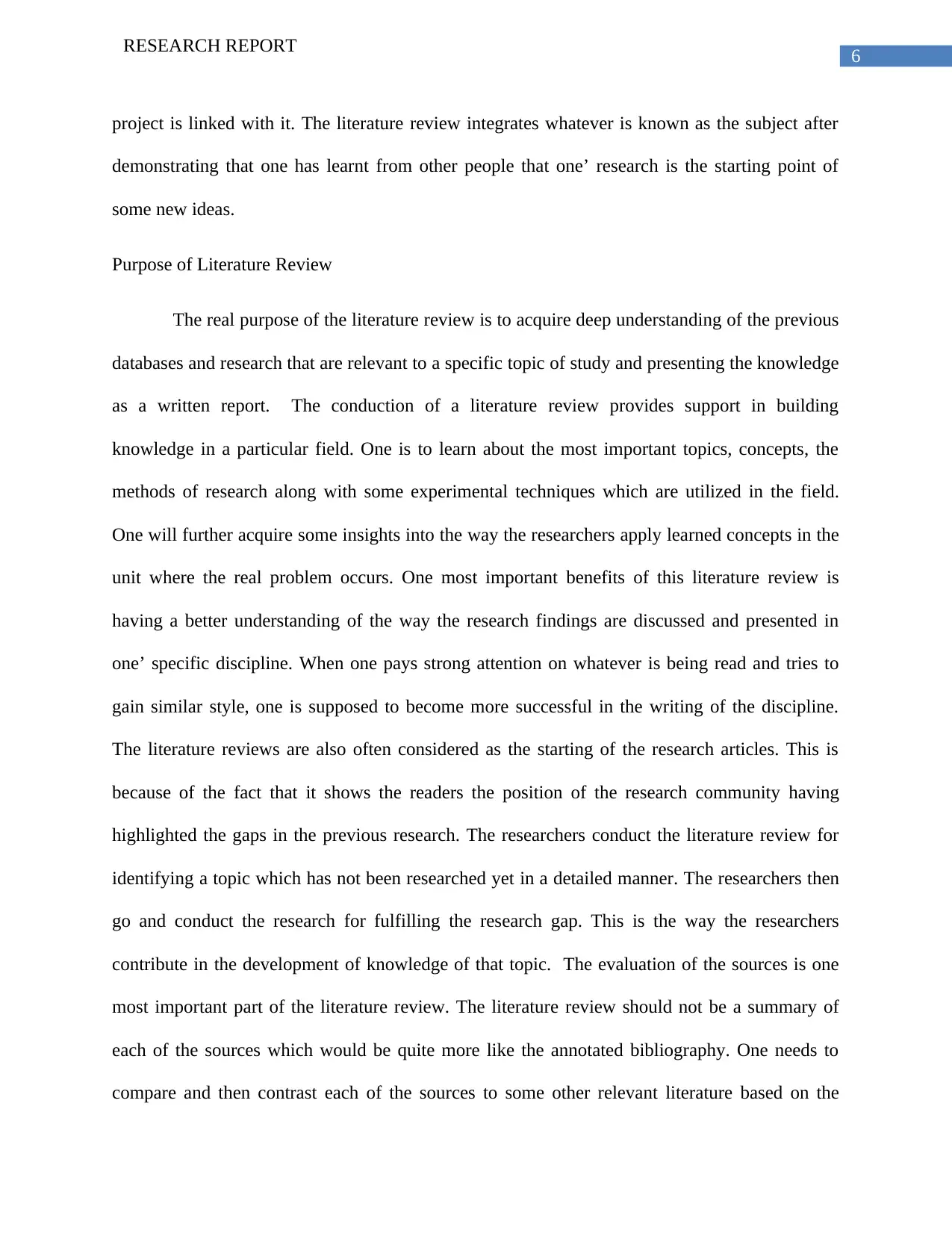
6
RESEARCH REPORT
project is linked with it. The literature review integrates whatever is known as the subject after
demonstrating that one has learnt from other people that one’ research is the starting point of
some new ideas.
Purpose of Literature Review
The real purpose of the literature review is to acquire deep understanding of the previous
databases and research that are relevant to a specific topic of study and presenting the knowledge
as a written report. The conduction of a literature review provides support in building
knowledge in a particular field. One is to learn about the most important topics, concepts, the
methods of research along with some experimental techniques which are utilized in the field.
One will further acquire some insights into the way the researchers apply learned concepts in the
unit where the real problem occurs. One most important benefits of this literature review is
having a better understanding of the way the research findings are discussed and presented in
one’ specific discipline. When one pays strong attention on whatever is being read and tries to
gain similar style, one is supposed to become more successful in the writing of the discipline.
The literature reviews are also often considered as the starting of the research articles. This is
because of the fact that it shows the readers the position of the research community having
highlighted the gaps in the previous research. The researchers conduct the literature review for
identifying a topic which has not been researched yet in a detailed manner. The researchers then
go and conduct the research for fulfilling the research gap. This is the way the researchers
contribute in the development of knowledge of that topic. The evaluation of the sources is one
most important part of the literature review. The literature review should not be a summary of
each of the sources which would be quite more like the annotated bibliography. One needs to
compare and then contrast each of the sources to some other relevant literature based on the
RESEARCH REPORT
project is linked with it. The literature review integrates whatever is known as the subject after
demonstrating that one has learnt from other people that one’ research is the starting point of
some new ideas.
Purpose of Literature Review
The real purpose of the literature review is to acquire deep understanding of the previous
databases and research that are relevant to a specific topic of study and presenting the knowledge
as a written report. The conduction of a literature review provides support in building
knowledge in a particular field. One is to learn about the most important topics, concepts, the
methods of research along with some experimental techniques which are utilized in the field.
One will further acquire some insights into the way the researchers apply learned concepts in the
unit where the real problem occurs. One most important benefits of this literature review is
having a better understanding of the way the research findings are discussed and presented in
one’ specific discipline. When one pays strong attention on whatever is being read and tries to
gain similar style, one is supposed to become more successful in the writing of the discipline.
The literature reviews are also often considered as the starting of the research articles. This is
because of the fact that it shows the readers the position of the research community having
highlighted the gaps in the previous research. The researchers conduct the literature review for
identifying a topic which has not been researched yet in a detailed manner. The researchers then
go and conduct the research for fulfilling the research gap. This is the way the researchers
contribute in the development of knowledge of that topic. The evaluation of the sources is one
most important part of the literature review. The literature review should not be a summary of
each of the sources which would be quite more like the annotated bibliography. One needs to
compare and then contrast each of the sources to some other relevant literature based on the
⊘ This is a preview!⊘
Do you want full access?
Subscribe today to unlock all pages.

Trusted by 1+ million students worldwide
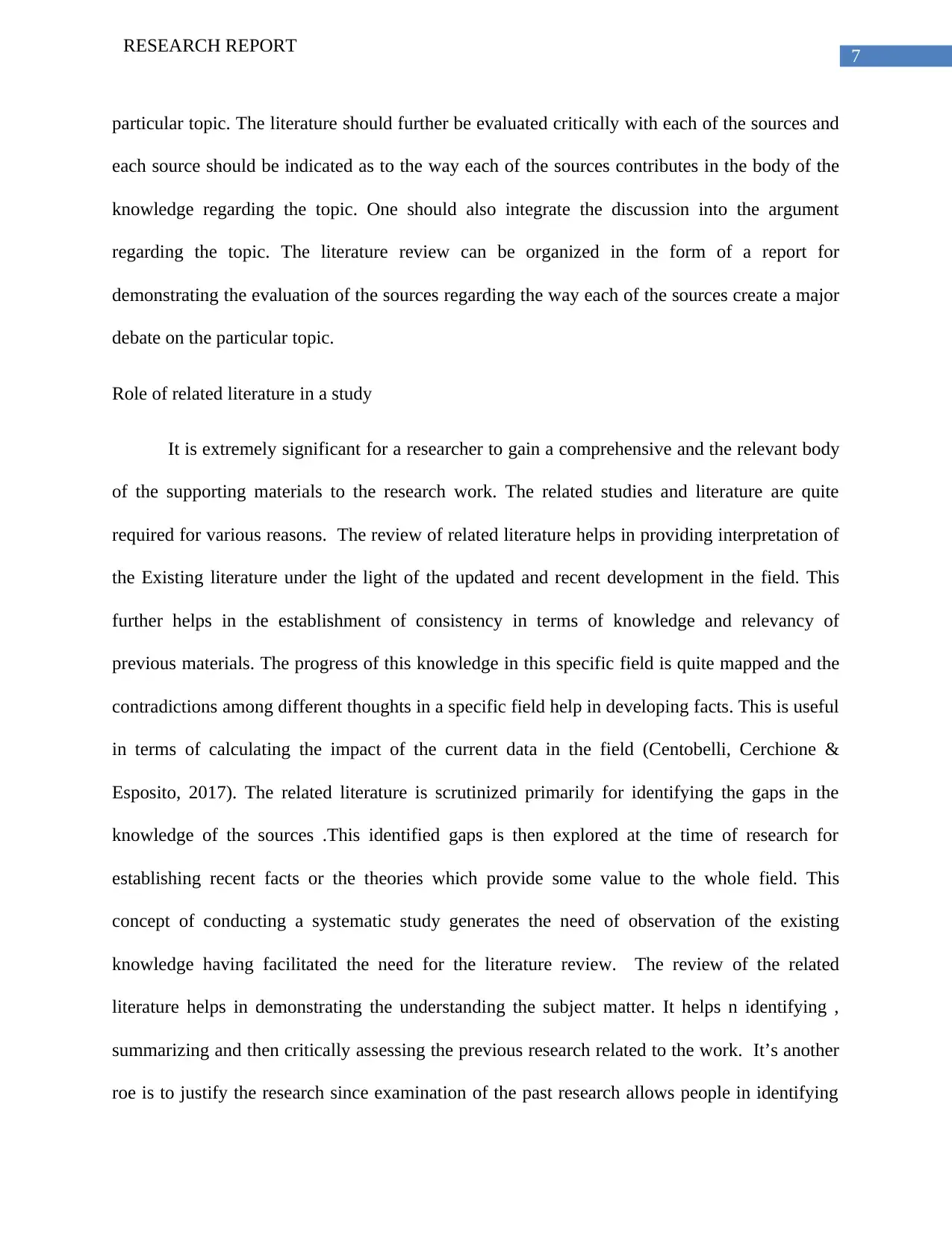
7
RESEARCH REPORT
particular topic. The literature should further be evaluated critically with each of the sources and
each source should be indicated as to the way each of the sources contributes in the body of the
knowledge regarding the topic. One should also integrate the discussion into the argument
regarding the topic. The literature review can be organized in the form of a report for
demonstrating the evaluation of the sources regarding the way each of the sources create a major
debate on the particular topic.
Role of related literature in a study
It is extremely significant for a researcher to gain a comprehensive and the relevant body
of the supporting materials to the research work. The related studies and literature are quite
required for various reasons. The review of related literature helps in providing interpretation of
the Existing literature under the light of the updated and recent development in the field. This
further helps in the establishment of consistency in terms of knowledge and relevancy of
previous materials. The progress of this knowledge in this specific field is quite mapped and the
contradictions among different thoughts in a specific field help in developing facts. This is useful
in terms of calculating the impact of the current data in the field (Centobelli, Cerchione &
Esposito, 2017). The related literature is scrutinized primarily for identifying the gaps in the
knowledge of the sources .This identified gaps is then explored at the time of research for
establishing recent facts or the theories which provide some value to the whole field. This
concept of conducting a systematic study generates the need of observation of the existing
knowledge having facilitated the need for the literature review. The review of the related
literature helps in demonstrating the understanding the subject matter. It helps n identifying ,
summarizing and then critically assessing the previous research related to the work. It’s another
roe is to justify the research since examination of the past research allows people in identifying
RESEARCH REPORT
particular topic. The literature should further be evaluated critically with each of the sources and
each source should be indicated as to the way each of the sources contributes in the body of the
knowledge regarding the topic. One should also integrate the discussion into the argument
regarding the topic. The literature review can be organized in the form of a report for
demonstrating the evaluation of the sources regarding the way each of the sources create a major
debate on the particular topic.
Role of related literature in a study
It is extremely significant for a researcher to gain a comprehensive and the relevant body
of the supporting materials to the research work. The related studies and literature are quite
required for various reasons. The review of related literature helps in providing interpretation of
the Existing literature under the light of the updated and recent development in the field. This
further helps in the establishment of consistency in terms of knowledge and relevancy of
previous materials. The progress of this knowledge in this specific field is quite mapped and the
contradictions among different thoughts in a specific field help in developing facts. This is useful
in terms of calculating the impact of the current data in the field (Centobelli, Cerchione &
Esposito, 2017). The related literature is scrutinized primarily for identifying the gaps in the
knowledge of the sources .This identified gaps is then explored at the time of research for
establishing recent facts or the theories which provide some value to the whole field. This
concept of conducting a systematic study generates the need of observation of the existing
knowledge having facilitated the need for the literature review. The review of the related
literature helps in demonstrating the understanding the subject matter. It helps n identifying ,
summarizing and then critically assessing the previous research related to the work. It’s another
roe is to justify the research since examination of the past research allows people in identifying
Paraphrase This Document
Need a fresh take? Get an instant paraphrase of this document with our AI Paraphraser
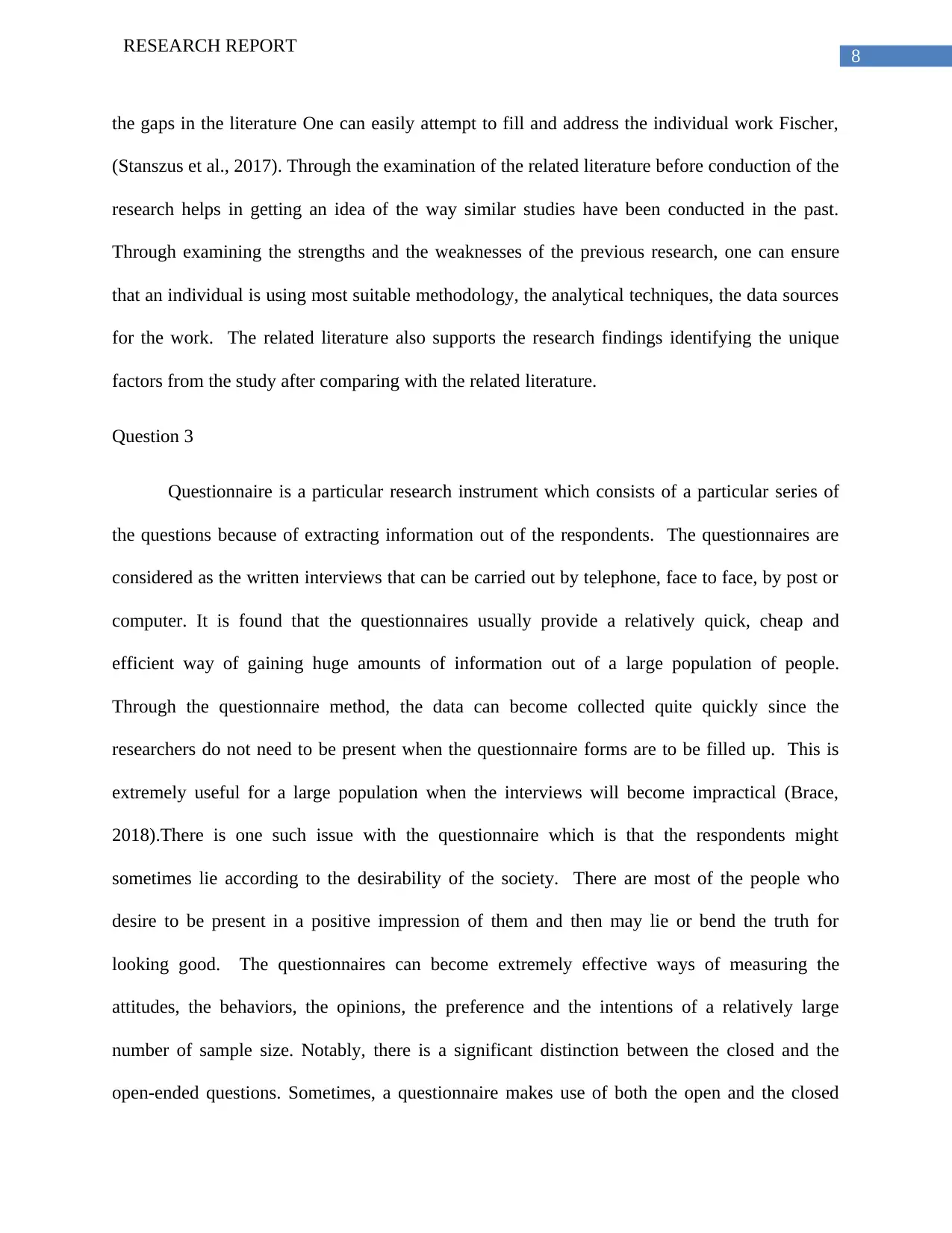
8
RESEARCH REPORT
the gaps in the literature One can easily attempt to fill and address the individual work Fischer,
(Stanszus et al., 2017). Through the examination of the related literature before conduction of the
research helps in getting an idea of the way similar studies have been conducted in the past.
Through examining the strengths and the weaknesses of the previous research, one can ensure
that an individual is using most suitable methodology, the analytical techniques, the data sources
for the work. The related literature also supports the research findings identifying the unique
factors from the study after comparing with the related literature.
Question 3
Questionnaire is a particular research instrument which consists of a particular series of
the questions because of extracting information out of the respondents. The questionnaires are
considered as the written interviews that can be carried out by telephone, face to face, by post or
computer. It is found that the questionnaires usually provide a relatively quick, cheap and
efficient way of gaining huge amounts of information out of a large population of people.
Through the questionnaire method, the data can become collected quite quickly since the
researchers do not need to be present when the questionnaire forms are to be filled up. This is
extremely useful for a large population when the interviews will become impractical (Brace,
2018).There is one such issue with the questionnaire which is that the respondents might
sometimes lie according to the desirability of the society. There are most of the people who
desire to be present in a positive impression of them and then may lie or bend the truth for
looking good. The questionnaires can become extremely effective ways of measuring the
attitudes, the behaviors, the opinions, the preference and the intentions of a relatively large
number of sample size. Notably, there is a significant distinction between the closed and the
open-ended questions. Sometimes, a questionnaire makes use of both the open and the closed
RESEARCH REPORT
the gaps in the literature One can easily attempt to fill and address the individual work Fischer,
(Stanszus et al., 2017). Through the examination of the related literature before conduction of the
research helps in getting an idea of the way similar studies have been conducted in the past.
Through examining the strengths and the weaknesses of the previous research, one can ensure
that an individual is using most suitable methodology, the analytical techniques, the data sources
for the work. The related literature also supports the research findings identifying the unique
factors from the study after comparing with the related literature.
Question 3
Questionnaire is a particular research instrument which consists of a particular series of
the questions because of extracting information out of the respondents. The questionnaires are
considered as the written interviews that can be carried out by telephone, face to face, by post or
computer. It is found that the questionnaires usually provide a relatively quick, cheap and
efficient way of gaining huge amounts of information out of a large population of people.
Through the questionnaire method, the data can become collected quite quickly since the
researchers do not need to be present when the questionnaire forms are to be filled up. This is
extremely useful for a large population when the interviews will become impractical (Brace,
2018).There is one such issue with the questionnaire which is that the respondents might
sometimes lie according to the desirability of the society. There are most of the people who
desire to be present in a positive impression of them and then may lie or bend the truth for
looking good. The questionnaires can become extremely effective ways of measuring the
attitudes, the behaviors, the opinions, the preference and the intentions of a relatively large
number of sample size. Notably, there is a significant distinction between the closed and the
open-ended questions. Sometimes, a questionnaire makes use of both the open and the closed
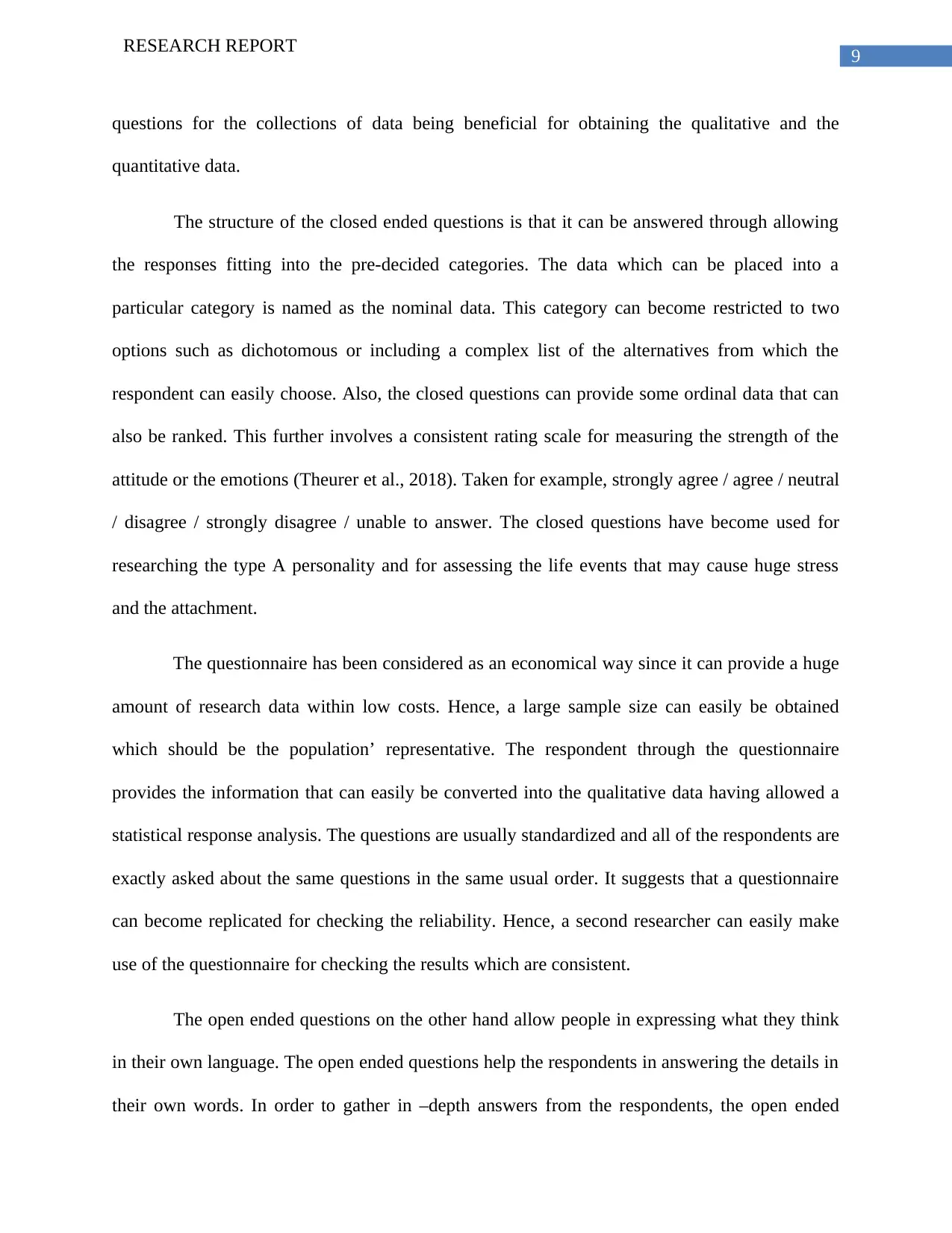
9
RESEARCH REPORT
questions for the collections of data being beneficial for obtaining the qualitative and the
quantitative data.
The structure of the closed ended questions is that it can be answered through allowing
the responses fitting into the pre-decided categories. The data which can be placed into a
particular category is named as the nominal data. This category can become restricted to two
options such as dichotomous or including a complex list of the alternatives from which the
respondent can easily choose. Also, the closed questions can provide some ordinal data that can
also be ranked. This further involves a consistent rating scale for measuring the strength of the
attitude or the emotions (Theurer et al., 2018). Taken for example, strongly agree / agree / neutral
/ disagree / strongly disagree / unable to answer. The closed questions have become used for
researching the type A personality and for assessing the life events that may cause huge stress
and the attachment.
The questionnaire has been considered as an economical way since it can provide a huge
amount of research data within low costs. Hence, a large sample size can easily be obtained
which should be the population’ representative. The respondent through the questionnaire
provides the information that can easily be converted into the qualitative data having allowed a
statistical response analysis. The questions are usually standardized and all of the respondents are
exactly asked about the same questions in the same usual order. It suggests that a questionnaire
can become replicated for checking the reliability. Hence, a second researcher can easily make
use of the questionnaire for checking the results which are consistent.
The open ended questions on the other hand allow people in expressing what they think
in their own language. The open ended questions help the respondents in answering the details in
their own words. In order to gather in –depth answers from the respondents, the open ended
RESEARCH REPORT
questions for the collections of data being beneficial for obtaining the qualitative and the
quantitative data.
The structure of the closed ended questions is that it can be answered through allowing
the responses fitting into the pre-decided categories. The data which can be placed into a
particular category is named as the nominal data. This category can become restricted to two
options such as dichotomous or including a complex list of the alternatives from which the
respondent can easily choose. Also, the closed questions can provide some ordinal data that can
also be ranked. This further involves a consistent rating scale for measuring the strength of the
attitude or the emotions (Theurer et al., 2018). Taken for example, strongly agree / agree / neutral
/ disagree / strongly disagree / unable to answer. The closed questions have become used for
researching the type A personality and for assessing the life events that may cause huge stress
and the attachment.
The questionnaire has been considered as an economical way since it can provide a huge
amount of research data within low costs. Hence, a large sample size can easily be obtained
which should be the population’ representative. The respondent through the questionnaire
provides the information that can easily be converted into the qualitative data having allowed a
statistical response analysis. The questions are usually standardized and all of the respondents are
exactly asked about the same questions in the same usual order. It suggests that a questionnaire
can become replicated for checking the reliability. Hence, a second researcher can easily make
use of the questionnaire for checking the results which are consistent.
The open ended questions on the other hand allow people in expressing what they think
in their own language. The open ended questions help the respondents in answering the details in
their own words. In order to gather in –depth answers from the respondents, the open ended
⊘ This is a preview!⊘
Do you want full access?
Subscribe today to unlock all pages.

Trusted by 1+ million students worldwide
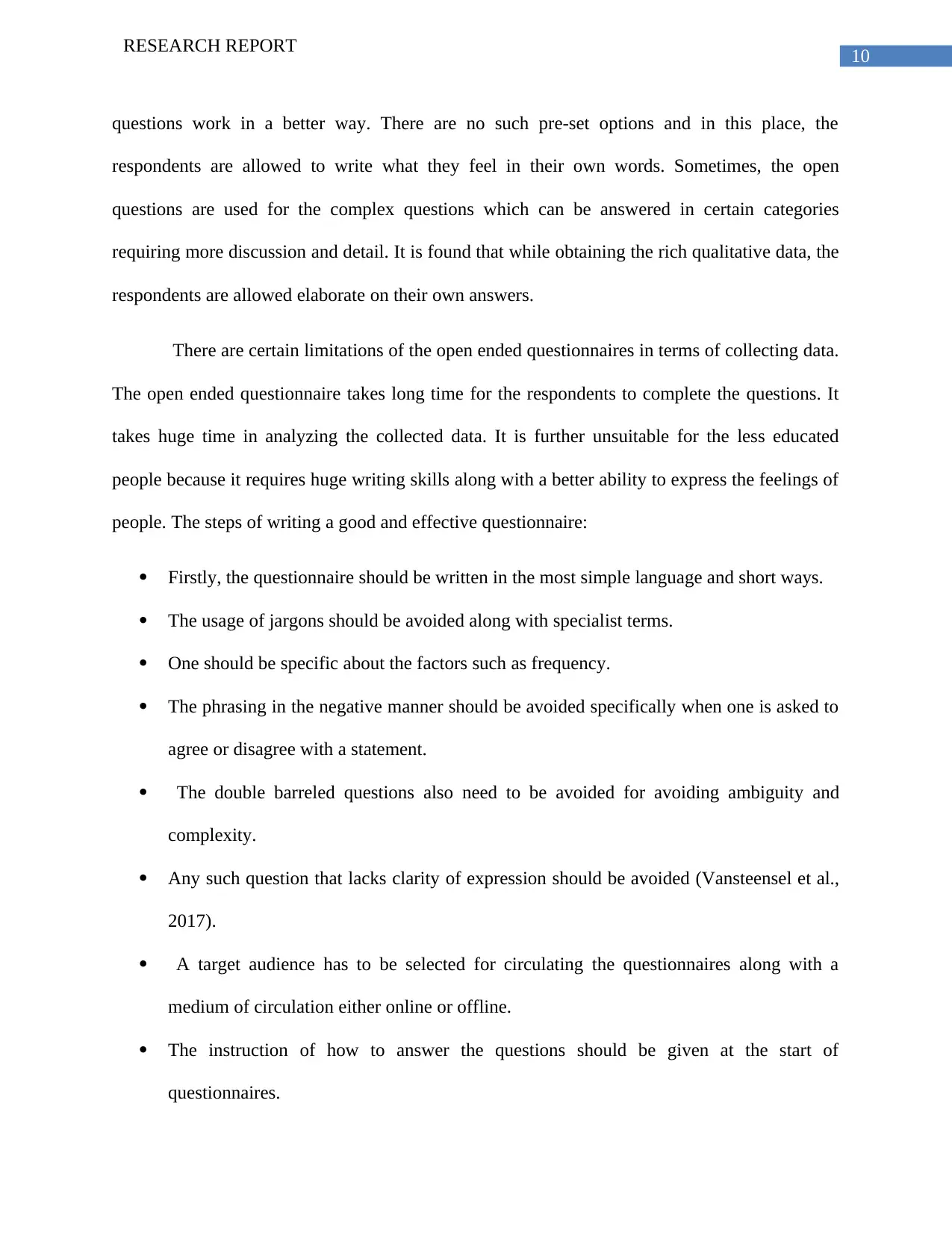
10
RESEARCH REPORT
questions work in a better way. There are no such pre-set options and in this place, the
respondents are allowed to write what they feel in their own words. Sometimes, the open
questions are used for the complex questions which can be answered in certain categories
requiring more discussion and detail. It is found that while obtaining the rich qualitative data, the
respondents are allowed elaborate on their own answers.
There are certain limitations of the open ended questionnaires in terms of collecting data.
The open ended questionnaire takes long time for the respondents to complete the questions. It
takes huge time in analyzing the collected data. It is further unsuitable for the less educated
people because it requires huge writing skills along with a better ability to express the feelings of
people. The steps of writing a good and effective questionnaire:
Firstly, the questionnaire should be written in the most simple language and short ways.
The usage of jargons should be avoided along with specialist terms.
One should be specific about the factors such as frequency.
The phrasing in the negative manner should be avoided specifically when one is asked to
agree or disagree with a statement.
The double barreled questions also need to be avoided for avoiding ambiguity and
complexity.
Any such question that lacks clarity of expression should be avoided (Vansteensel et al.,
2017).
A target audience has to be selected for circulating the questionnaires along with a
medium of circulation either online or offline.
The instruction of how to answer the questions should be given at the start of
questionnaires.
RESEARCH REPORT
questions work in a better way. There are no such pre-set options and in this place, the
respondents are allowed to write what they feel in their own words. Sometimes, the open
questions are used for the complex questions which can be answered in certain categories
requiring more discussion and detail. It is found that while obtaining the rich qualitative data, the
respondents are allowed elaborate on their own answers.
There are certain limitations of the open ended questionnaires in terms of collecting data.
The open ended questionnaire takes long time for the respondents to complete the questions. It
takes huge time in analyzing the collected data. It is further unsuitable for the less educated
people because it requires huge writing skills along with a better ability to express the feelings of
people. The steps of writing a good and effective questionnaire:
Firstly, the questionnaire should be written in the most simple language and short ways.
The usage of jargons should be avoided along with specialist terms.
One should be specific about the factors such as frequency.
The phrasing in the negative manner should be avoided specifically when one is asked to
agree or disagree with a statement.
The double barreled questions also need to be avoided for avoiding ambiguity and
complexity.
Any such question that lacks clarity of expression should be avoided (Vansteensel et al.,
2017).
A target audience has to be selected for circulating the questionnaires along with a
medium of circulation either online or offline.
The instruction of how to answer the questions should be given at the start of
questionnaires.
Paraphrase This Document
Need a fresh take? Get an instant paraphrase of this document with our AI Paraphraser
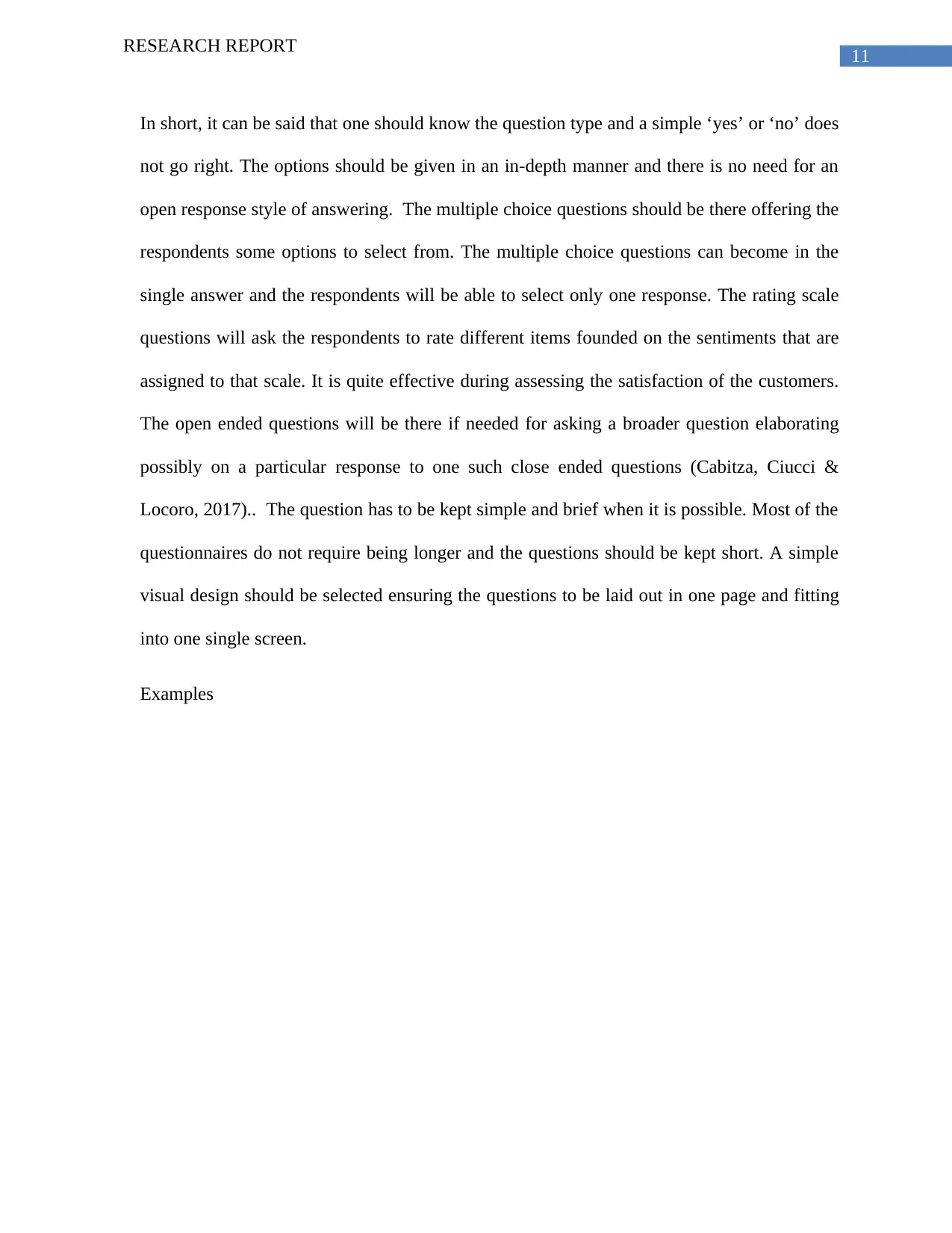
11
RESEARCH REPORT
In short, it can be said that one should know the question type and a simple ‘yes’ or ‘no’ does
not go right. The options should be given in an in-depth manner and there is no need for an
open response style of answering. The multiple choice questions should be there offering the
respondents some options to select from. The multiple choice questions can become in the
single answer and the respondents will be able to select only one response. The rating scale
questions will ask the respondents to rate different items founded on the sentiments that are
assigned to that scale. It is quite effective during assessing the satisfaction of the customers.
The open ended questions will be there if needed for asking a broader question elaborating
possibly on a particular response to one such close ended questions (Cabitza, Ciucci &
Locoro, 2017).. The question has to be kept simple and brief when it is possible. Most of the
questionnaires do not require being longer and the questions should be kept short. A simple
visual design should be selected ensuring the questions to be laid out in one page and fitting
into one single screen.
Examples
RESEARCH REPORT
In short, it can be said that one should know the question type and a simple ‘yes’ or ‘no’ does
not go right. The options should be given in an in-depth manner and there is no need for an
open response style of answering. The multiple choice questions should be there offering the
respondents some options to select from. The multiple choice questions can become in the
single answer and the respondents will be able to select only one response. The rating scale
questions will ask the respondents to rate different items founded on the sentiments that are
assigned to that scale. It is quite effective during assessing the satisfaction of the customers.
The open ended questions will be there if needed for asking a broader question elaborating
possibly on a particular response to one such close ended questions (Cabitza, Ciucci &
Locoro, 2017).. The question has to be kept simple and brief when it is possible. Most of the
questionnaires do not require being longer and the questions should be kept short. A simple
visual design should be selected ensuring the questions to be laid out in one page and fitting
into one single screen.
Examples
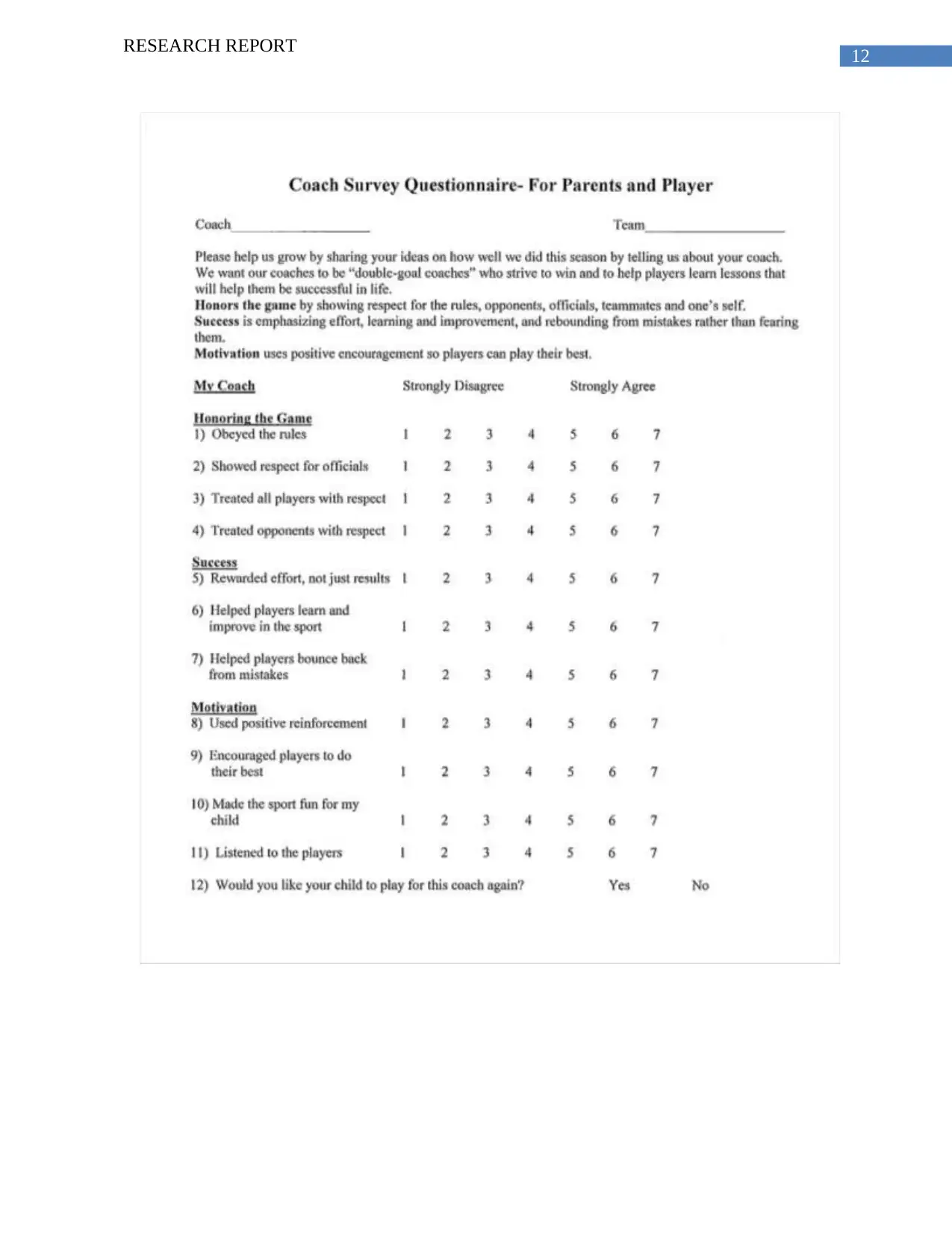
12
RESEARCH REPORT
RESEARCH REPORT
⊘ This is a preview!⊘
Do you want full access?
Subscribe today to unlock all pages.

Trusted by 1+ million students worldwide
1 out of 15
Related Documents
Your All-in-One AI-Powered Toolkit for Academic Success.
+13062052269
info@desklib.com
Available 24*7 on WhatsApp / Email
![[object Object]](/_next/static/media/star-bottom.7253800d.svg)
Unlock your academic potential
Copyright © 2020–2025 A2Z Services. All Rights Reserved. Developed and managed by ZUCOL.





